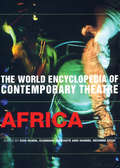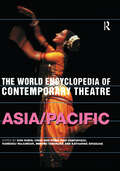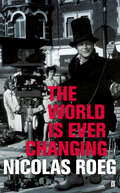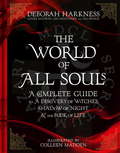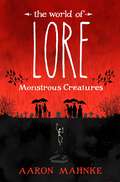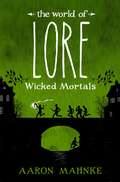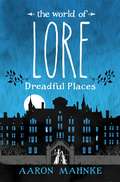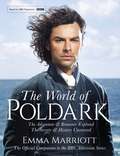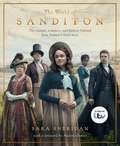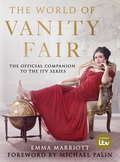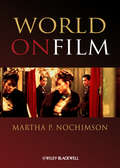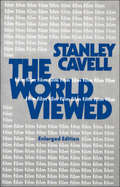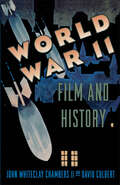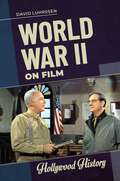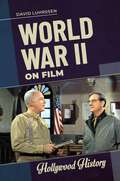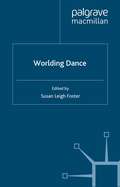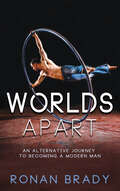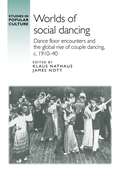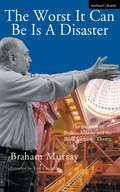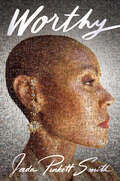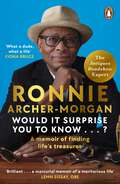- Table View
- List View
World Encyclopedia of Contemporary Theatre: Africa (World Encyclopedia Of Contemporary Theatre Ser.)
by Don Rubin Ousmane Diakhaté Hansel Ndumbe EyohNow available in paperback for the first time this edition of the World Encyclopedia of Contemporary Theatre series examines theatrical developments in Africa since 1945. Entries on thirty-two African countries are featured in this volume, preceded by specialist introductory essays on Anglophone Africa, Francophone Africa, History and Culture, Cosmology, Music, Dance, Theatre for Young Audiences and Puppetry. There are also special introductory general essays on African theatre written by Nobel Prize Laureate Wole Soyinka and the outstanding Congolese playwright, Sony Labou Tansi, before his untimely death in 1995. More up-to-date and more wide-ranging than any other publication, this is undoubtedly a major ground-breaking survey of contemporary African theatre.
The World Encyclopedia of Contemporary Theatre: Volume 5: Asia/Pacific
by Don Rubin Chua Soo Pong Ravi Chaturvedi Ramendu Majumdar Minoru Tanokura Katherine BrisbaneThis new paperback edition provides a unique examination of theatre in Asia and the Pacific and is written by leading experts from within the countries covered. Its far-reaching scope and broad interpretation of theatre (to include all types of performance) set it apart from any other similar publication. Entries on 33 Asian countries are featured in this volume, preceded by introductory essays on Asian Theatre, Theatre in the Pacific, History and Culture, Cosmology, Music, Dance, Theatre for Young Audiences, Mask Theatre and Puppetry.The volume contains approximately 300,000 words and includes national essays of up to 25,000 words each. The countries include:Afghanistan * Australia * Bangladesh * Bhutan * Brunei * Cambodia * India * Indonesia * Iran * Japan * Kazakhstan *Kirghizia * Laos * Malaysia * Myanmar * Mongolia * Nepal *New Zealand * Pakistan * Papua New Guinea * PhilippinesNew Zealand * Pakistan * Papua New Guinea * Philippines *Singapore * South Korea * South Pacific * Sri Lanka * Tadjikistan * Thailand * Turkmenistan * Vietnam
The World Encyclopedia of Contemporary Theatre: Volume 5: Asia/Pacific
This new paperback edition provides a unique examination of theatre in Asia and the Pacific and is written by leading experts from within the countries covered. Its far-reaching scope and broad interpretation of theatre (to include all types of performance) set it apart from any other similar publication. Entries on 33 Asian countries are featured in this volume, preceded by introductory essays on Asian Theatre, Theatre in the Pacific, History and Culture, Cosmology, Music, Dance, Theatre for Young Audiences, Mask Theatre and Puppetry.The volume contains approximately 300,000 words and includes national essays of up to 25,000 words each. The countries include:Afghanistan * Australia * Bangladesh * Bhutan * Brunei * Cambodia * India * Indonesia * Iran * Japan * Kazakhstan *Kirghizia * Laos * Malaysia * Myanmar * Mongolia * Nepal *New Zealand * Pakistan * Papua New Guinea * PhilippinesNew Zealand * Pakistan * Papua New Guinea * Philippines *Singapore * South Korea * South Pacific * Sri Lanka * Tadjikistan * Thailand * Turkmenistan * Vietnam
The World is Ever Changing: Enhanced edition
by Nicolas RoegNicolas Roeg is one of the most distinctive and influential film-makers of his generation. The generation of film-makers who define contemporary movie-making - Danny Boyle, Kevin Macdonald (The Last King of Scotland), Christopher Nolan (The Dark Knight), James Marsh (Man on Wire), and Guillermo Del Toro (Pan's Labyrinth), all acknowledge their debt to the work of Nicolas Roeg.Roeg began as a cameraman, working for such masters as Francois Truffaut and David Lean. His explosive debut as a director with Performance, established an approach to film-making that was unconventional and ever-changing, creating works such as Don't Look Now, The Man Who Fell to Earth, Bad Timing, Insignificance, and, more recently, Puffball.Having now reached eighty years of age, Roeg has decided to pass on to the next generations, the wealth of wisdom and experience he has garnered over fifty years of film-making.
The World of All Souls: A Complete Guide to A Discovery of Witches, Shadow of Night and The Book of Life (All Souls Trilogy Ser.)
by Deborah HarknessDiscover the truths, the history, the myths and the magic behind the bestselling All Souls trilogy. Fall under the spell once more with this all-encompassing insider's guide to A Discovery of Witches, Shadow of Night and The Book of Life. The All Souls trilogy by Deborah Harkness, featuring historian and witch Diana Bishop and vampire scientist Matthew Clairmont, delves into mythology, alchemy, literature and architecture. And history is brought to life. With her signature historian's touch, Deborah Harkness offers an encyclopaedic look at the series, complete with synopses, character biographies, maps, recipes, and even the science behind creatures, magic and alchemy. Bursting with fascinating facts and original artwork, The World of All Souls is the ultimate companion for fans of the All Souls trilogy and unlocks this fantastical world, letting you in on all its secrets and mysteries. Praise for the All Souls trilogy: 'This is a glorious, finely-wrought gem of a book: intelligent, thoughtful, intricate. . . Utterly enchanting on every level' Manda Scott on A DISCOVERY OF WITCHES 'Deborah Harkness writes as if she's the hugely more talented love child of Diana Gabaldon and J. K. Rowling' thebookbag.co.uk on SHADOW OF NIGHT 'Rich in arcane detail, fans will relish this exotic cauldron of romantic fantasy' Sunday Mirror on THE BOOK OF LIFE
The World of Lore, Volume 1: Now a major online streaming series (The World of Lore #1)
by Aaron MahnkeA fascinating, beautifully illustrated collection of stories from the hit podcast Lore - now an online streaming series They live in shadows - deep in the forest, late in the night, in the dark recesses of our mind. They're spoken of in stories and superstitions, relics of an unenlightened age, old wives' tales, passed down through generations. And yet, no matter how wary and jaded we have become, as individuals or as a society, a part of us remains vulnerable to them. Werewolves and wendigos, poltergeists and vampires, angry elves and vengeful spirits.In this beautifully illustrated volume, the host of the hit podcast Lore serves as a guide on a fascinating journey through the history of these terrifying creatures, and explores not only the legends but what they tell us about ourselves. Aaron Mahnke invites us to the desolate Pine Barrens of New Jersey, where the notorious winged, red-eyed Jersey Devil dwells. Mahnke delves into harrowing accounts of cannibalism-some officially documented, others the stuff of speculation . . . perhaps. He visits the dimly lit rooms where séances take place, the European villages where gremlins make mischief, and Key West, Florida, home of a haunted doll named Robert.The monsters of folklore have become not only a part of our language but a part of our collective psyche. Whether these beasts and bogeymen are real or just a reflection of our primal fears, we know, on some level, that not every mystery has been explained, and that the unknown still holds the power to strike fear deep in our hearts and souls. As Aaron Mahnke reminds us, sometimes the truth is even scarier than the lore...Praise for the Lore podcast'Truth can often be much scarier than fiction - something Mahnke proves as he dives deep into the world of folklore and the darker side of history in a quest to root out the fragment of truth at the bottom of our fears." - Entertainment Weekly'Narrated by Mahnke in a style that evokes spooky campfire stories, Lore is a history lesson like no other.' - Esquire
The World of Lore, Volume 2: Now a major online streaming series (The World of Lore #2)
by Aaron MahnkeA chilling, lavishly illustrated who's-who of the most despicable people ever to walk the earth, featuring both rare and best-loved stories from the hit podcast Lore, now an online streaming series. Here are the incredible true stories of some of the mortals who achieved notoriety in history and folklore through horrible means. Monsters of this sort - serial killers, desperate criminals, and socially mobile people with a much darker double-life - are, in fact, quite real . . . including H. H. Holmes, the infamous Chicago serial killer; William Brodie, the Edinburgh criminal mastermind who inspired The Strange Case of Dr. Jekyll and Mr. Hyde; and Bela Kiss, a Hungarian tinsmith with a most disturbing hobby: collecting women in gasoline drums. As Aaron Mahnke reminds us, sometimes the truth is even more frightening than the lore.
The World of Lore, Volume 3: Now a major online streaming series (The World of Lore #3)
by Aaron MahnkeFor fans of Neil Gaiman and Welcome to Night Vale, Aaron Mahnke's The World of Lore (based on the hit LORE podcast) explores the chilling truth behind the legendary creatures, peculiar people and horrific places that arouse our deepest fears. Now on online streaming seriesVolume 3: Dreadful PlacesThis third book in The World of Lore series will explore dark and dreadful places on land and at sea, places haunted by tragedy and filled with echoes of evil. These are the stories about cities, and buildings, too, from New Orleans to Louisiana and Richmond, Virginia, as well as infamous places like the Stanley Hotel in Colorado and England's most frightening and brooding castles...
The World of Poldark
by Emma MarriottEmma Marriott's The World of Poldark explores the characters, the compelling stories and the era that Winston Graham - and the television series - set out to recreate, the England that Ross Poldark returned to from the American War of Independence. England, and especially Cornwall, was then marked by social unrest and a deep division between rich and poor. It was a place of tin mines and shipwrecks, of new money versus old, of harsh justice and great kindness. And, above all, it was a place that inspired Winston Graham's beloved novels. Amid the turmoil of eighteenth-century Cornwall, Ross comes back to a home in ruins, his father dead and his childhood sweetheart engaged to another - his own heart as battered as the country around him. Experience the great houses and the glorious landscapes and follow the cast of characters as their stories play out against the backdrop of Cornwall's wild beauty, through interviews with the actors, behind the scenes insights and in-depth information on costumes, props and locations. Packed full of behind the scenes photographs, The World of Poldark is the ultimate guide to the popular series.
The World of Sanditon: The Official Companion to the ITV Series
by Sara SheridanThe official TV tie-in to accompany the ITV drama scripted by Andrew DaviesThe official companion to ITV's hotly anticipated new drama, The World of Sanditon delves behind the scenes of Sanditon, giving you the inside scoop on Jane Austen's unfinished masterpiece, adapted for television by Andrew Davies.Produced by Red Planet Pictures, ITV's Sanditon series tells the story of the joyously impulsive, spirited and unconventional Charlotte Heywood and her spiky relationship with the humorous, charming and slightly wild Sidney Parker. Written by Emmy and BAFTA-Award winning writer Andrew Davies, the series will bring Austen's story to life and this book will allow you to go behind the scenes of the cast and crew, exploring the world that Austen created and offering fascinating insights about the period and about the real-life heartbreak behind her final story. Readers will also have access to location guides, interviews with the cast, and in-depth historical information by esteemed author Sara Sheridan.Full of beautiful photography from the series, this is the only guide you need to Autumn's biggest show - welcome to Sanditon!
The World of Vanity Fair
by Emma MarriottTHE OFFICIAL COMPANION TO THE ITV SERIESWilliam Thackeray's Vanity Fair was first published in the 1840s, but its power to entertain and provoke debate remains as strong as ever. The tales of charismatic, shrewd, and amoral Becky Sharp's journey from Miss Pinkerton's academy for young ladies to a wider world in which wealth and status is valued above all else is arguably as relevant today as it was nearly 200 years ago: Becky and her equally flawed friends and acquaintances are familiar to us all.This, the official companion to the ITV series contains everything a fan could want to know about the story. It explores the characters Thackeray so memorably created and the society they inhabited, along with fascinating insights about the period. And it offers location guides, behind the scenes details, and interviews with the cast, alongside beautiful illustrations and set photography.Taking readers from London society to the battlefields of Waterloo, the book gets right to the heart of one of the greatest novels ever written.
World on Film: An Introduction
by Martha P. NochimsonThis uniquely engaging and lively textbook provides a comprehensive introduction to international film, from the golden age of European cinema to the contemporary blockbusters of India and Asia, and the post World War II emergence of global film culture. Offers an overview of film culture in European countries such as France, Sweden and Spain, as well as Africa, Hong Kong, China, and India, in a clear and conversational style to engage the student reader Provides a detailed exploration of the impact of globalization on international cinema Includes a comprehensive companion website (www.wiley.com/go/worldonfilm) with an expansive gallery of film stills also found in the text, plus access to sample syllabi for faculty and a detailed FAQ Addresses the differences in visual and narrative strategies between Hollywood-influenced movies and international cinema Highlights key words within the text and provides a comprehensive glossary of critical vocabulary for film studies Each chapter includes in-depth case studies of individual films and directors, cultural and historical context, selected filmographies, and ideas for projects, essays, and further research
The World Viewed: Reflections on the Ontology of Film, Enlarged Edition (Harvard Film Studies (hup) Ser.)
by Stanley CavellStanley Cavell looks closely at America’s most popular art and our perceptions of it. His explorations of Hollywood’s stars, directors, and most famous films—as well as his fresh look at Godard, Bergman, and other great European directors—will be of lasting interest to movie-viewers and intelligent people everywhere.
World War II, Film, and History
by John Whiteclay Chambers David CulbertThe immediacy and perceived truth of the visual image, as well as film and television's ability to propel viewers back into the past, place the genre of the historical film in a special category. War films--including antiwar films--have established the prevailing public image of war in the twentieth century. For American audiences, the dominant image of trench warfare in World War I has been provided by feature films such as All Quiet on the Western Front and Paths of Glory. The image of combat in the Second World War has been shaped by films like Sands of Iwo Jima and The Longest Day. And despite claims for the alleged impact of widespread television coverage of the Vietnam War, it is actually films such as Apocalypse Now and Platoon which have provided the most powerful images of what is seen as the "reality" of that much disputed conflict. But to what degree does history written "with lightning," as Woodrow Wilson allegedly said, represent the reality of the past? To what extent is visual history an oversimplification, or even a distortion of the past? Exploring the relationship between moving images and the society and culture in which they were produced and received, World War II, Film, and History addresses the power these images have had in determining our perception and memories of war. Examining how the public memory of war in the twentieth century has often been created more by a manufactured past than a remembered one, a leading group of historians discusses films dating from the early 1930s through the early 1990s, created by filmmakers the world over, from the United States and Germany to Japan and the former Soviet Union. For example, Freda Freiberg explains how the inter-racial melodramatic Japanese feature film China Nights, in which a manly and protective Japanese naval officer falls in love with a beautiful young Chinese street waif and molds her into a cultured, submissive wife, proved enormously popular with wartime Japanese and helped justify the invasion of China in the minds of many Japanese viewers. Peter Paret assesses the historical accuracy of Kolberg as a depiction of an unsuccessful siege of that German city by a French Army in 1807, and explores how the film, released by Hitler's regime in January 1945, explicitly called for civilian sacrifice and last-ditch resistance. Stephen Ambrose contrasts what we know about the historical reality of the Allied D-Day landings in Normandy on June 6, 1944, with the 1962 release of The Longest Day, in which the major climactic moment in the film never happened at Normandy. Alice Kessler-Harris examines The Life and Times of Rosie the Riveter, a 1982 film documentary about women defense workers on the American home front in World War II, emphasizing the degree to which the documentary's engaging main characters and its message of the need for fair and equal treatment for women resonates with many contemporary viewers. And Clement Alexander Price contrasts Men of Bronze, William Miles's fine documentary about black American soldiers who fought in France in World War I, with Liberators, the controversial documentary by Miles and Nina Rosenblum which incorrectly claimed that African-American troops liberated Holocaust survivors at Dachau in World War II. In today's visually-oriented world, powerful images, even images of images, are circulated in an eternal cycle, gaining increased acceptance through repetition. History becomes an endless loop, in which repeated images validate and reconfirm each other. Based on archival materials, many of which have become only recently available, World War II, Film, and History offers an informative and a disturbing look at the complex relationship between national myths and filmic memory, as well as the dangers of visual images being transformed into "reality."
World War II, Film, and History
by John Whiteclay Chambers David CulbertThe immediacy and perceived truth of the visual image, as well as film and television's ability to propel viewers back into the past, place the genre of the historical film in a special category. War films--including antiwar films--have established the prevailing public image of war in the twentieth century. For American audiences, the dominant image of trench warfare in World War I has been provided by feature films such as All Quiet on the Western Front and Paths of Glory. The image of combat in the Second World War has been shaped by films like Sands of Iwo Jima and The Longest Day. And despite claims for the alleged impact of widespread television coverage of the Vietnam War, it is actually films such as Apocalypse Now and Platoon which have provided the most powerful images of what is seen as the "reality" of that much disputed conflict. But to what degree does history written "with lightning," as Woodrow Wilson allegedly said, represent the reality of the past? To what extent is visual history an oversimplification, or even a distortion of the past? Exploring the relationship between moving images and the society and culture in which they were produced and received, World War II, Film, and History addresses the power these images have had in determining our perception and memories of war. Examining how the public memory of war in the twentieth century has often been created more by a manufactured past than a remembered one, a leading group of historians discusses films dating from the early 1930s through the early 1990s, created by filmmakers the world over, from the United States and Germany to Japan and the former Soviet Union. For example, Freda Freiberg explains how the inter-racial melodramatic Japanese feature film China Nights, in which a manly and protective Japanese naval officer falls in love with a beautiful young Chinese street waif and molds her into a cultured, submissive wife, proved enormously popular with wartime Japanese and helped justify the invasion of China in the minds of many Japanese viewers. Peter Paret assesses the historical accuracy of Kolberg as a depiction of an unsuccessful siege of that German city by a French Army in 1807, and explores how the film, released by Hitler's regime in January 1945, explicitly called for civilian sacrifice and last-ditch resistance. Stephen Ambrose contrasts what we know about the historical reality of the Allied D-Day landings in Normandy on June 6, 1944, with the 1962 release of The Longest Day, in which the major climactic moment in the film never happened at Normandy. Alice Kessler-Harris examines The Life and Times of Rosie the Riveter, a 1982 film documentary about women defense workers on the American home front in World War II, emphasizing the degree to which the documentary's engaging main characters and its message of the need for fair and equal treatment for women resonates with many contemporary viewers. And Clement Alexander Price contrasts Men of Bronze, William Miles's fine documentary about black American soldiers who fought in France in World War I, with Liberators, the controversial documentary by Miles and Nina Rosenblum which incorrectly claimed that African-American troops liberated Holocaust survivors at Dachau in World War II. In today's visually-oriented world, powerful images, even images of images, are circulated in an eternal cycle, gaining increased acceptance through repetition. History becomes an endless loop, in which repeated images validate and reconfirm each other. Based on archival materials, many of which have become only recently available, World War II, Film, and History offers an informative and a disturbing look at the complex relationship between national myths and filmic memory, as well as the dangers of visual images being transformed into "reality."
World War II on Film (Hollywood History)
by David LuhrssenWorld War II on Film examines the war through the lens of 12 films. The movies selected include productions made during World War II and in each succeeding decade, providing a sense of how different generations perceive the war.World War II on Film provides a succinct yet well-grounded appraisal of that war as seen through 12 representative films. The book separates fact from fiction, showing where the movies were accurate and where they departed from reality, and places them in the larger context of historical and social events. Each movie chosen represents a particular aspect of the conflict, including the air war over Europe, the condition of prisoners of war, Nazi atrocities, and the British evacuation at Dunkirk. Unlike most histories of Hollywood during World War II or the genre of war movies, World War II on Film examines in depth the relation between the depictions of events, beliefs, attitudes, and ways of life as seen on film with reality as documented by historians or recorded by journalists or eye-witnesses to the war. The volume will appeal to high school and college readers, as well as general interest readers and film buffs.
World War II on Film (Hollywood History)
by David LuhrssenWorld War II on Film examines the war through the lens of 12 films. The movies selected include productions made during World War II and in each succeeding decade, providing a sense of how different generations perceive the war.World War II on Film provides a succinct yet well-grounded appraisal of that war as seen through 12 representative films. The book separates fact from fiction, showing where the movies were accurate and where they departed from reality, and places them in the larger context of historical and social events. Each movie chosen represents a particular aspect of the conflict, including the air war over Europe, the condition of prisoners of war, Nazi atrocities, and the British evacuation at Dunkirk. Unlike most histories of Hollywood during World War II or the genre of war movies, World War II on Film examines in depth the relation between the depictions of events, beliefs, attitudes, and ways of life as seen on film with reality as documented by historians or recorded by journalists or eye-witnesses to the war. The volume will appeal to high school and college readers, as well as general interest readers and film buffs.
Worlding Dance (Studies in International Performance)
by S. FosterWhat world has been constructed for dancing through the use of the term 'world dance'? What kinds of worlds do we as scholars create for a given dance when we undertake to describe and analyze it? This book endeavours to make new epistemological space for the analysis of the world's dance by offering a variety of new analytic approaches.
Worlds Apart: An Alternative Journey to becoming a Modern Man
by Ronan Brady‘Ronan is emblematic of how Ireland has changed.’ – Panti BlissAt just under six foot in his socks and weighing in at fourteen stone, Ronan Brady is a solid slab of rarest Roscommon meat. He has a natural tendency to throw himself about – some would say recklessly, others would say enthusiastically – into whatever he sets himself to. Ronan had a ‘normal’ childhood in Roscommon and knew by the time he was a teenager that when he grew up he wanted to play football for his county and become a teacher. Ronan had achieved his life ambition when he took up ‘Flying’ as a hobby. A hobby that transformed his life and took him to heights he never dreamed of, performing in the smash hit show Riot alongside Panti Bliss, and going on to tour the world. Worlds Apart is an open, humorous account of Ronan’s life journey.
Worlds of social dancing: Dance floor encounters and the global rise of couple dancing, c. 1910–40 (Studies in Popular Culture)
by Jeffrey RichardsBy the 1920s, much of the world was ‘dance mad,’ as dancers from Buenos Aires to Tokyo, from Manchester to Johannesburg and from Chelyabinsk to Auckland, engaged in the Charleston, the foxtrot and a whole host of other fashionable dances. Worlds of social dancing examines how these dance cultures spread around the globe at this time and how they were altered to suit local tastes. As it looks at dance as a ‘social world’, the book explores the social and personal relationships established in encounters on dance floors on all continents. It also acknowledges the impact of radio and (sound) film as well as the contribution of dance teachers, musicians and other entertainment professionals to the making of the new dance culture.
Worlds of social dancing: Dance floor encounters and the global rise of couple dancing, c. 1910–40 (Studies in Popular Culture)
by Jeffrey RichardsBy the 1920s, much of the world was ‘dance mad,’ as dancers from Buenos Aires to Tokyo, from Manchester to Johannesburg and from Chelyabinsk to Auckland, engaged in the Charleston, the foxtrot and a whole host of other fashionable dances. Worlds of social dancing examines how these dance cultures spread around the globe at this time and how they were altered to suit local tastes. As it looks at dance as a ‘social world’, the book explores the social and personal relationships established in encounters on dance floors on all continents. It also acknowledges the impact of radio and (sound) film as well as the contribution of dance teachers, musicians and other entertainment professionals to the making of the new dance culture.
The Worst It Can Be Is A Disaster: The Life Story of Braham Murray and the Royal Exchange Theatre (Biography and Autobiography)
by Braham MurrayThe Worst It Can Be is a Disaster is the autobiography of Braham Murray, founding director of the Royal Exchange Manchester which in 2006 celebrated its thirtieth anniversary. With a foreword by Sir Tom Courtenay.Born into a Jewish family, Braham Murray struggled against his parents' expectations that he should follow them into the world of commerce; instead he became at twenty-two the youngest artistic director in the country when he took over Century Theatre, a theatre company based in Manchester. Detailing his relationships and the theatrical successes and flops along the way, the narrative takes us through his early years with Century Theatre, with the 69 Theatre Company, and the birth of the Royal Exchange Manchester in the heart of Manchester in 1976. Twenty years later, the theatre rose from the ashes of the IRA bomb brilliantly opening a new production on time just ten days after the bomb had destroyed the city centre. The role and influence of the author's Jewish heritage and of his key collaborators - including Caspar Wrede and Michael Elliott - are explored in this illuminating and inspiring account of one of English theatre's great directors.'Braham's passion is sometimes overwhelming, sometimes annoying but completely inspirational. It's his passion that the Royal Exchange has thrived on, and this book is full of his passion for the theatre.' Robert Lindsay
The Worst It Can Be Is A Disaster: The Life Story of Braham Murray and the Royal Exchange Theatre (Biography and Autobiography)
by Braham MurrayThe Worst It Can Be is a Disaster is the autobiography of Braham Murray, founding director of the Royal Exchange Manchester which in 2006 celebrated its thirtieth anniversary. With a foreword by Sir Tom Courtenay.Born into a Jewish family, Braham Murray struggled against his parents' expectations that he should follow them into the world of commerce; instead he became at twenty-two the youngest artistic director in the country when he took over Century Theatre, a theatre company based in Manchester. Detailing his relationships and the theatrical successes and flops along the way, the narrative takes us through his early years with Century Theatre, with the 69 Theatre Company, and the birth of the Royal Exchange Manchester in the heart of Manchester in 1976. Twenty years later, the theatre rose from the ashes of the IRA bomb brilliantly opening a new production on time just ten days after the bomb had destroyed the city centre. The role and influence of the author's Jewish heritage and of his key collaborators - including Caspar Wrede and Michael Elliott - are explored in this illuminating and inspiring account of one of English theatre's great directors.'Braham's passion is sometimes overwhelming, sometimes annoying but completely inspirational. It's his passion that the Royal Exchange has thrived on, and this book is full of his passion for the theatre.' Robert Lindsay
Worthy
by Jada Pinkett SmithA gripping, painfully honest, and ultimately inspirational memoir from global superstar and creator of the Red Table Talk series Jada Pinkett Smith.
Would It Surprise You To Know…?
by Janet Gleeson Ronnie Archer-Morgan'A fascinating, rollercoaster read, very well told.' - Times'Ronnie has overcome a heart-breaking start in life to achieve great success and no one deserves it more. What a dude, what a life!' - Fiona BruceFor decades, Ronnie Archer-Morgan has brought to life the fascinating, often surprising backstories behind our most cherished heirlooms and household objects on the Antiques Roadshow. Now, he tells his own unlikely story. Born in the fifties to a Sierra Leonean mother battling mental health problems, Ronnie spent his childhood in and out of care. After difficult beginnings, marked by abuse, racism and brushes with both criminals and the police, he got into music, managing to get DJ gigs and, later, worked as a celebrity hairdresser for Vidal Sassoon and Smile in the height of seventies London. A flair for spotting antiques led him to start his own Knightsbridge gallery, ultimately becoming one of the most respected figures in the industry, culminating in a regular spot as an expert on the nation's Sunday favourite, Antiques Roadshow. Told with rich warmth, this is an extraordinary journey from deprivation and abuse to adventure and success against the odds - with stories of the incredible objects which shaped the way.'A surprising story, like many of the objects he appraises on the Antiques Roadshow' - Kate Adie, broadcaster and bestselling author
